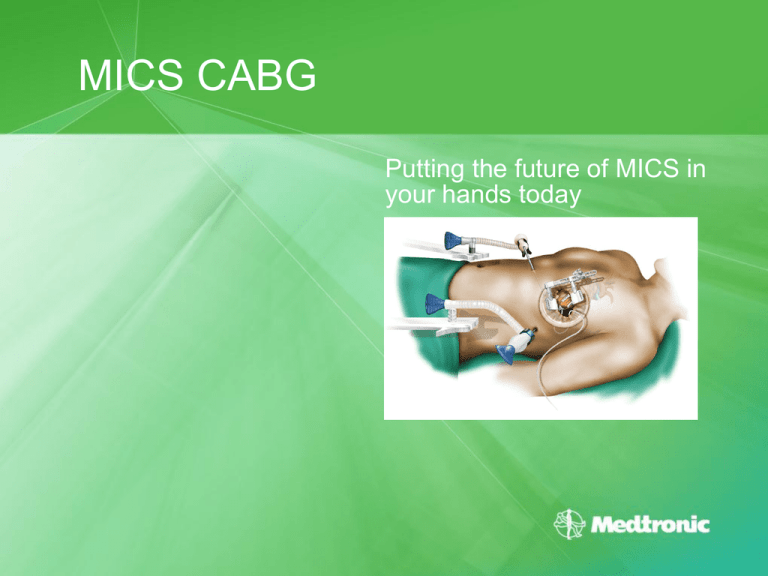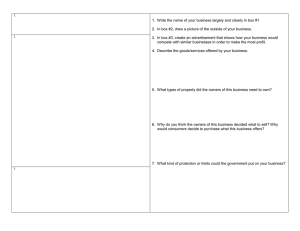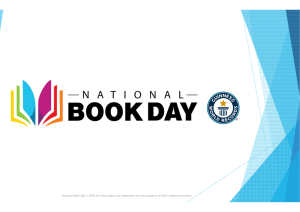MICS CABG - Medtronic
advertisement

MICS CABG Putting the future of MICS in your hands today This presentation is based on a compilation of the surgical techniques and protocols of: Dr. Joseph McGinn - Staten Island, New York Dr. Marc Ruel - Ottawa, Canada Dr. Steven Hoff - Nashville, TN Coronary Heart Disease • CHD is the leading cause of death in the United States for both men and women • CAD (Coronary Artery Disease) is the most common type of heart disease • Lifestyle changes, drug therapy, and/or medical procedures can effectively prevent or treat CAD in most people • Most patients are first managed with drug therapy – if that doesn’t work… What is the next step? Source - American Heart Association – Heart Disease and Stroke Statistics Update - 2006 Trademarks may be registered and are the property of their respective owners. CABG Surgery: Standard of Care • Clearly, invasive cardiac surgery is not a first-line treatment for patients where less invasive options, such as angioplasty and stenting, are feasible. Nevertheless, for many patients with advanced or diffuse disease, surgery remains the best option. While the advent of DES has cannibalized certain segments of the revascularization caseload, current research suggests that chronic total occlusions, patients with left main disease, diabetics and those with diffuse multi-vessel disease are best served by surgical intervention.1 • CABG surgery is the standard of care, and when the left internal mammary artery (LIMA) is grafted to the left anterior descending artery (LAD), patency rates are higher than 95% at 10 years, setting an extremely high benchmark for stenting to match.2 1 Hannan EL, Wu C, Walford G, Culliford AT, et al. Drug-eluting stents vs. coronary-artery bypass grafting in multivessel coronary disease. N Engl J Med. Jan. 24 2008; 358(4):331-341. 2 Loop FD, Lytle BW, Cosgrove DM, et al. Influence of the internal-mammary-artery graft on 10-year survival and other cardiac events. N Engl J Med. Jan 2 1986, 314(1):1-6. Trademarks may be registered and are the property of their respective owners. CABG or Stents for Multi-vessel Disease? New England Journal of Medicine shared the following conclusion: “For patients with multivessel disease, CABG continues to be associated with lower mortality rates than does treatment with drug-eluting stents and is also associated with lower rates of death or myocardial infarction and repeat revascularization.” Trademarks may be registered and are the property of their respective owners. Convergence of Technology and Specialties • Utilizing multiple technologies to decide what is right for the patient • What is the best outcome for the patient? How do the cardiovascular specialties get there together? • Disease management and patient management – not procedure oriented • It does not matter to the patient which specialty treats them – they just want the best treatment • Getting all the specialists on the same page to deliver the right care to the patient Trademarks may be registered and are the property of their respective owners. Hybrid Operating Room • Definition: – • A melding of the cardiac cath lab and cardiac surgery operating room Potential: – Allows select patients to undergo intravascular interventions and cardiac surgery simultaneously to treat coronary artery disease, minimize recovery time and postoperative pain – Hospital-Physician Drivers • Attract top surgeons and staff • Increase procedural volumes • Provide efficiencies that generate revenue • Allows expanded use of technology, fosters advances in techniques and enables expansion of coronary artery disease treatment Trademarks may be registered and are the property of their respective owners. Hybrid Operating Room • Therapies: – • Suitable for treating a wide variety of conditions • Diseases of the coronary artery, valve, congenital heart, thoracic aorta • Heart failure/cardiac rhythm disturbances Considerations: – Suitable Specialties and technologies converge • Multiple technologies can be leveraged to determine what is right for the patient. • What is the best outcome for the patient? How do the cardiovascular specialties get there together? • Patient management and disease management come first, not the procedure. • Specialists need to be on the same page to deliver the right care to the patient. Trademarks may be registered and are the property of their respective owners. Overall MICS Technologies Trends Goal MICS: Technique Improvement Technology Improvement Efficacy Sternotomy Surgery Invasiveness Trademarks may be registered and are the property of their respective owners. MICS CABG Evolution Incision Size (cm) 25 20cm 20 15 5-7cm 10 2-4cm +ports 5 0 Sternotomy MICS CABG Robotic OR time Training challenge Start up and ongoing costs Trademarks may be registered and are the property of their respective owners. I’ve Seen This All Before…. • • Not the old Minimally Invasive Direct CABG (MIDCAB) Disadvantages of MIDCAB – – – – – 1 Poor early results in the mid-late 90’s Rib-spreading and parasternal incision is painful to patients Primarily for single vessel disease (LIMA-LAD) Less access and ability to harvest the length of the LIMA Poor target visibility and access due to medial incision McGinn JT, Usman S, Lapierre H, Pothula VR, Mesana TG, Ruel M. Minimally invasive coronary artery bypass grafting: dual center experience in 450 consecutive patients. Circulation.2009; 120:S78-S84. Trademarks may be registered and are the property of their respective owners. MICS CABG vs. MIDCAB Trademarks may be registered and are the property of their respective owners. Patient Selection/Inclusion Criteria • Coronary Anatomy – Left main coronary artery disease (CAD) with normal right coronary artery (RCA) – Triple vessel disease with medium to large posterior descending artery (PDA) – Complex proximal left sided lesions with or without large branch involvement – Previous unsuccessful stenting Trademarks may be registered and are the property of their respective owners. Patient Selection/Inclusion Criteria • Co-Morbidities: Includes patients who are at a high risk for problems with median sternotomy – Long-term steroid use – Severe chronic obstructive pulmonary disease (COPD) – Advanced age – Need for other major operative procedures – Severe deconditioning – Patients with arthritic or orthopedic problems – Patients who want the procedure and seek out less invasive surgical options Trademarks may be registered and are the property of their respective owners. Contraindications • Contraindications – Emergency cases – Patients with hemodynamic instability • Potential Contraindications – Previous CABG surgery – Morbid obesity – Patients with posterolateral branch disease – EF < 20% – Patients with peripheral vascular disease (PVD) – Patients with dilated cardiomyopathy Trademarks may be registered and are the property of their respective owners. MICS CABG Overview • • • • • Off-pump CABG procedure Lateral mini-thoracotomy LIMA takedown via direct vision, with video assistance, or robotically Anastomoses performed under direct vision through the thoracotomy Complete revascularization in multi-vessel disease, a pumpassisted beating heart or hybrid approach Trademarks may be registered and are the property of their respective owners. Why MICS? The Patient Perspective… • Better cosmetic outcome – No sternotomy scar • Less physical restrictions1 • Shorter length of stay1 • Quicker return to normal activities2 1 Poston 2 RS, Tran R, Collins M, et al. Comparison of economic and patient outcomes with minimally invasive versus traditional off-pump coronary artery bypass grafting techniques. Ann Surg. 2008:248:638-646. Lapierre H, Chan V, Sohmer B, Mesana TG, Ruel M. Minimally invasive coronary artery bypass grafting via small thoracotomy versus off-pump: a case-matched study. Eur J Cardiothorac Surg. 2011;40:804-810. Trademarks may be registered and are the property of their respective owners. MICS CABG Incisions Trademarks may be registered and are the property of their respective owners. Why MICS CABG? MICS CABG is the next step: • Similar grafting strategy to sternotomy CABG • Enduring results (LIMA-LAD)1 • Shortened hospital stay and recovery time2 • Avoid a sternotomy and improve the cosmetic outcome • Attractive alternative for patients and cardiologist 1 Loop FD, Lytle BW, Cosgrove DM, et al. Influence of the internal-mammary-artery graft on 10-year survival and other cardiac events. N Engl J Med. Jan 2 1986, 314(1):1-6. 2 Poston RS, Tran R, Collins M, et al. Comparison of economic and patient outcomes with minimally invasive versus traditional off-pump coronary artery bypass grafting techniques. Ann Surg. 2008:248:638-646. Trademarks may be registered and are the property of their respective owners. Why MICS? The Surgeon Perspective… • New skill set in a competitive market – Get an edge with cardiologists in their respective markets • Increase referrals from cardiologists • Marketing opportunity for the practice • Gain patients back with hybrid that were lost to stents • Increase case load • Economic benefit to the hospital – Hospital • Reduced length of stay1 • Can competitively market advanced cardiac procedures 1 Poston RS, Tran R, Collins M, et al. Comparison of economic and patient outcomes with minimally invasive versus traditional off-pump coronary artery bypass grafting techniques. Ann Surg. 2008:248:638-646. Trademarks may be registered and are the property of their respective owners. Mediastinitis = Lower Reimbursement Source - American Heart Association – Heart Disease and Stroke Statistics Update Trademarks may be registered and are the property of their respective owners. MICS CABG –The Tools and Technology Starfish® NS Tissue Stabilizer Octopus® Nuvo Heart Postioner ThoraTrak® MICS Retractor System MICS CABG – The Medtronic Total Package • ThoraTrak® MICS Retractor System for access to minimally invasive cardiac surgery – Interchangeable blades to accommodate various cardiovascular procedures and anatomies – Low-profile design • Octopus® Nuvo for tissue stabilization – Low profile, flexible, strong, quick connect system • Starfish® NS for multi-vessel access - Ability to position for LAD, Diag, OM’s, PDA through a thoracotomy Trademarks may be registered and are the property of their respective owners. MICS CABG – Pump-assisted Beating Heart • Bio-Medicus® Femoral Cannula Kits - Arterial and Venous • All of the beating heart technology, with the addition of our worldclass cannula, for a pump-assisted approach allows for complete revascularization through a thoracotomy Trademarks may be registered and are the property of their respective owners. MICS CABG Product Overview • • • ThoraTrak® MICS Retractor System Octopus® Nuvo Tissue Stabilizer Starfish® NS Heart Positioner Trademarks may be registered and are the property of their respective owners. ThoraTrak® MICS Retractor System • Modular retractor system with interchangeable blades to accommodate various procedures and patient anatomies • Reusable, stainless steel retractor designed specifically for minimally invasive procedures • Low-profile design Trademarks may be registered and are the property of their respective owners. Octopus® Nuvo Tissue Stabilizer • Incorporation of the Octopus® Evolution headlink for minimally invasive – Malleable pods – Increased headlink flexibility and range of motion – Flexible suction tubing • Three pod design – Smaller headlink for MICS CABG procedure • Quick connect, detachable headlink • New whale tail • Improved flex arm Trademarks may be registered and are the property of their respective owners. Starfish® NS Heart Positioner • Enables multi-vessel therapy through a thoracotomy • Presents coronary artery for direct vision anastomosis • Remote shaft insertion eliminates clutter at the incision site • Dependable positioning technology that you are already using in your OPCAB patients • No additional suction tube Trademarks may be registered and are the property of their respective owners. MICS CABG Technology Overview* • Starfish® NS Heart Positioner through a sub-xyphoid incision • Octopus® Nuvo Tissue Stabilizer through the 6th ICS • Positioning and stabilization of several vessels directly under the mini-thoracotomy is possible • Active pain management with pain pump Trademarks may be registered and are the property of their respective owners. UC201105476a EN


